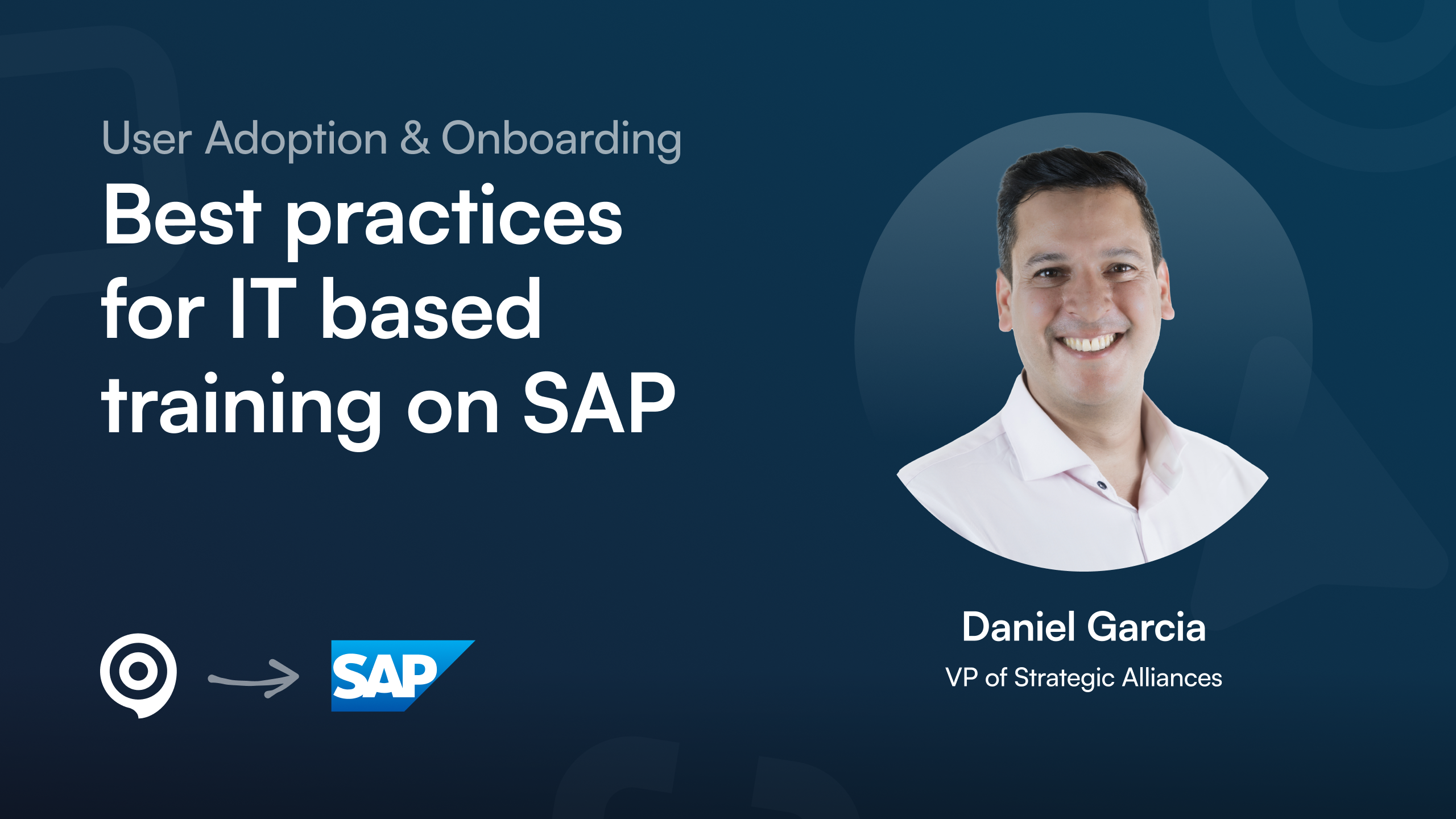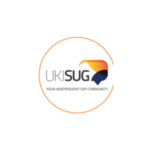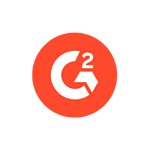Webinar
User Adoption & Onboarding: Best practices for IT based training on SAP

Are you upgrading your current SAP application or planning to transition to cloud ERP?
Then tune into our upcoming webinar where we cover how you can ensure success in your SAP project. Learn how to create adaptable, easy-to-follow training materials that remain relevant over time and are accessible to all users.
Agenda
- Accelerate your content creation process
- Keep documentation up-to-date
- Auto–translate user instructions into 45+ languages
- Enhance user onboarding experience and productivity
- Test your application’s processes automatically





Why effective SAP onboarding is critical for user adoption
Successful SAP implementations depend on people actually using the system correctly and enthusiastically. If end users aren’t properly onboarded, even the most powerful SAP solution can underdeliver. Research shows projects with a strong user adoption focus are far more likely to succeed. In fact, adoption has been identified as a #1 factor for SAP project success. This is because no matter how advanced the software, it only delivers value when business users embrace it and use it as intended.
Onboarding is the first critical step in that adoption journey. It’s during onboarding that users learn the new processes, get comfortable with the SAP interface, and begin to change old habits. Preparing users well for go-live directly correlates with higher adoption rates, as experts note that early readiness ensures users confidently utilize the system from day one. On the flip side, inadequate onboarding can breed resistance, errors, and workarounds that defeat the purpose of your SAP investment.
Adoption starts early: Don’t treat training as an afterthought. Begin user enablement during the project, not after.
Tie to business goals: Help users see “what’s in it for me” so they understand how the new SAP processes make their jobs easier or more effective.
Hands-on practice: Provide safe environments (sandboxes or simulations) where users can practice tasks before the real system goes live.
By treating SAP onboarding not as a one-time event but as a foundational phase of the project, organizations create a strong base for sustained user adoption. When users feel prepared and supported from the start, they are more likely to embrace the new system rather than resist it.
How IT-led training programs boost user readiness
Empowering your IT team (in partnership with training or HR) to lead the SAP training program can significantly improve user readiness. An IT-led training program means the people who understand the system best are deeply involved in teaching others. This has several advantages for readiness:
Accurate, up-to-date content: IT knows the current system configuration and upcoming changes. They can ensure the training materials reflect the real SAP environment and latest processes, preventing knowledge gaps.
Contextual expertise: IT trainers can explain not just how to do something in SAP but why it’s done that way, providing business context and technical reasoning. This helps users grasp the bigger picture and troubleshoot issues.
Early issue identification: As IT runs training sessions or supports e-learning development, they often spot confusing UI areas or process pain points. These can be addressed before go-live, improving system design or training focus to smooth out user experience.
Stronger support network: When IT leads onboarding, users form direct relationships with IT contacts. This makes users more comfortable seeking help later and fosters a culture of continuous learning.
A well-structured, IT-driven training program ensures that user readiness is a priority equal to technical go-live readiness. Interactive learning tools can be employed to make training engaging – for example, simulations or guided exercises that walk users through SAP transactions step by step. Such interactive, hands-on learning is proven to increase knowledge retention and confidence.
Moreover, involving IT doesn’t mean excluding others. It’s best when IT collaborates with business power users or trainers to blend technical accuracy with user-friendly delivery. The result is a training program that prepares employees thoroughly, so by the time go-live arrives, users are proficient and comfortable. The more ready your users are, the fewer go-live hiccups and support calls you’ll encounter.
Benefits of process-based training and documentation
Traditional training often dumps features and functions on users in a siloed way. Process-based training, however, centers the learning around real business workflows (end-to-end processes) that the user will perform in SAP. This approach is immensely beneficial for enterprise software onboarding:
Relevance: Users learn by following the actual processes they’ll do in their job (e.g. creating a sales order, running a financial close). Training is immediately relevant, which boosts engagement and understanding.
Contextual learning: By seeing how each step fits into a larger workflow, users comprehend not just what to do, but why it matters. This context helps them troubleshoot and adapt if variations occur.
Better retention: Step-by-step process documentation (with screenshots and clear instructions) serves as a memory aid after training. Users can refer to it on the job, which reinforces learning and reduces errors.
Consistency: With standardized process guides, every user follows the same approved steps. This consistency in execution means fewer deviations and more reliable data in SAP.
Comprehensive process documentation also greatly accelerates onboarding for new hires or team members in the future. One industry report noted that thorough documentation “reduces the time it takes to onboard new team members, enabling them to quickly familiarize themselves with the system’s configuration, customizations, and business processes”. In other words, good documentation shortens the learning curve. It also serves as an authoritative reference whenever questions arise, reducing dependency on calling support or super-users for help.
To implement process-based training, map out key user journeys in SAP. Then capture each task in a guide or learning module. Many organizations use tools or recorders to automatically generate step-by-step work instructions with screenshots for each process. These can be provided as PDFs, wikis, or interactive tutorials. The investment in detailed process documentation pays off through higher user competence and confidence. When training is rooted in real business processes, users more readily adopt the system as an integral part of their day-to-day work.
The importance of scalable content creation and continuous updates
SAP systems and business processes are not static – they evolve with patches, upgrades, and organizational changes. This makes it vital to have a scalable strategy for creating and updating training content. Without a sustainable approach, training materials quickly become outdated, and keeping them current turns into a resource drain.
A common pitfall is one-off documentation created during go-live that is never maintained. Within months, screenshots no longer match the system and procedures have changed, leaving users with misinformation. As one SAP training expert warned, “once your S/4 system is live you’ll need to constantly update your training materials to ensure your people know how to work effectively”. If your documentation method is manual (e.g. taking static screenshots), you might need an “army of people” to redo guides for each update. This is not scalable.
Instead, enterprises should adopt tools and processes that make updating content efficient:
-
Centralized knowledge base: Maintain a single source of truth (like an intranet site or learning portal) where all SAP help guides, videos, and FAQs reside. This way updates can be rolled out in one place for all users.
-
Modular content: Structure training content into bite-sized modules or chapters by topic. This allows you to update only the affected pieces when something changes, rather than rewriting an entire manual.
-
Recording tools: Leverage modern documentation tools that let you record processes and automatically generate outputs (documents, eLearning, simulations). These often allow easy re-recording or editing, so updating a process guide is faster and doesn’t require starting from scratch.
-
Version control and review: Put governance in place for periodic review of training content. For example, schedule a review cycle post each SAP release or quarterly. Authors can then update materials, and version control ensures users always access the latest approved content.
According to training best practices, companies should “create and maintain an up-to-date knowledge library” because SAP frequently releases updates to its software. Regular reviews of training materials ensure they stay aligned with the current system and business processes. This proactive updating prevents confusion and keeps user productivity high. It also lessens the support burden on IT, since users are less likely to encounter issues from following outdated instructions.
In summary, scalable content creation means thinking beyond go-live: How will you train the next wave of users, and the next? By investing in the right tools and a content governance process, you make SAP user onboarding repeatable, consistent, and able to keep up with change. This results in long-term adoption, not just a one-time training success.
Supporting post-go-live adoption with contextual in-app help
Even with great upfront training, users will inevitably have questions once they start using SAP in their daily jobs. New hires will come on board, and existing users may need to perform infrequent tasks they forgot how to do. Contextual in-app help is a game-changer for supporting users after go-live and sustaining high adoption levels.
Contextual help refers to providing guidance or tips right within the SAP application, at the moment of need. For example, a user in the SAP S/4HANA interface could click a help icon or trigger a guided walkthrough that shows them how to complete the current screen’s process. This just-in-time assistance has several benefits:
Instant support: Users get help immediately without leaving SAP to search manuals or call support. This reduces frustration and downtime.
Reinforcement of training: In-app guides act like a digital coach, reinforcing the correct steps learned in training. It prevents bad habits or guesswork from creeping in over time.
Better user adoption: When people know help is easily available in the system, they are more confident exploring new features and using the software to its fullest. This boosts overall adoption and feature utilization.
Reduced support tickets: Many “how do I do this?” questions can be answered by the software itself, freeing IT and support teams from repetitive queries.
Modern digital adoption solutions (sometimes built into SAP or via third-party tools) make it possible to embed such guided help. For instance, SAP’s own Enable Now platform provides online training and in-app help that improves user adoption and the efficiency of software programs across your enterprise. In practice, this might look like a popup overlay guiding a user through creating a purchase order, or a tooltip explaining a field in real-time. Other digital adoption platforms offer similar functionality, providing step-by-step on-screen guidance and even automation of routine input.
By leveraging contextual help, companies extend the support umbrella to every end user right at their workstation. It’s like having a virtual trainer available 24/7. Over time, this empowers users to solve problems on their own (“learn by doing”) and continuously learn new processes as SAP evolves. Post-go-live adoption is not a given – it requires nurturing. Contextual help is an efficient way to nurture and ensure the initial training sticks long after go-live.
In summary, fast, effective SAP user onboarding in large enterprises isn’t achieved by a single training session – it’s an ongoing journey. By focusing on early adoption through thorough onboarding, leveraging IT-led programs for realistic training, creating process-focused documentation, keeping content evergreen at scale, and supporting users with in-app guidance, organizations can significantly shorten the learning curve and encourage users to fully embrace SAP. The result is not only a smoother go-live, but also sustained productivity, fewer errors, and a stronger return on your SAP investment for years to come.